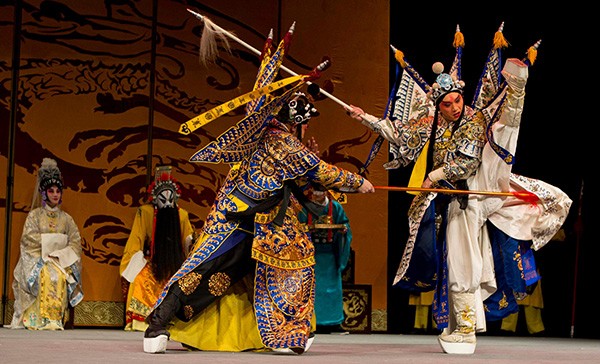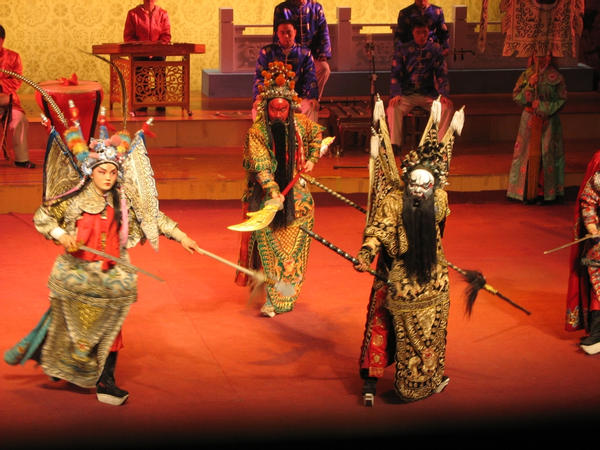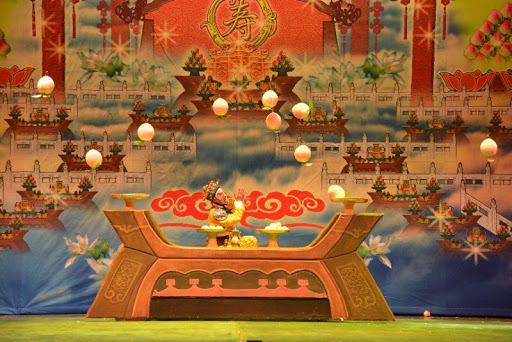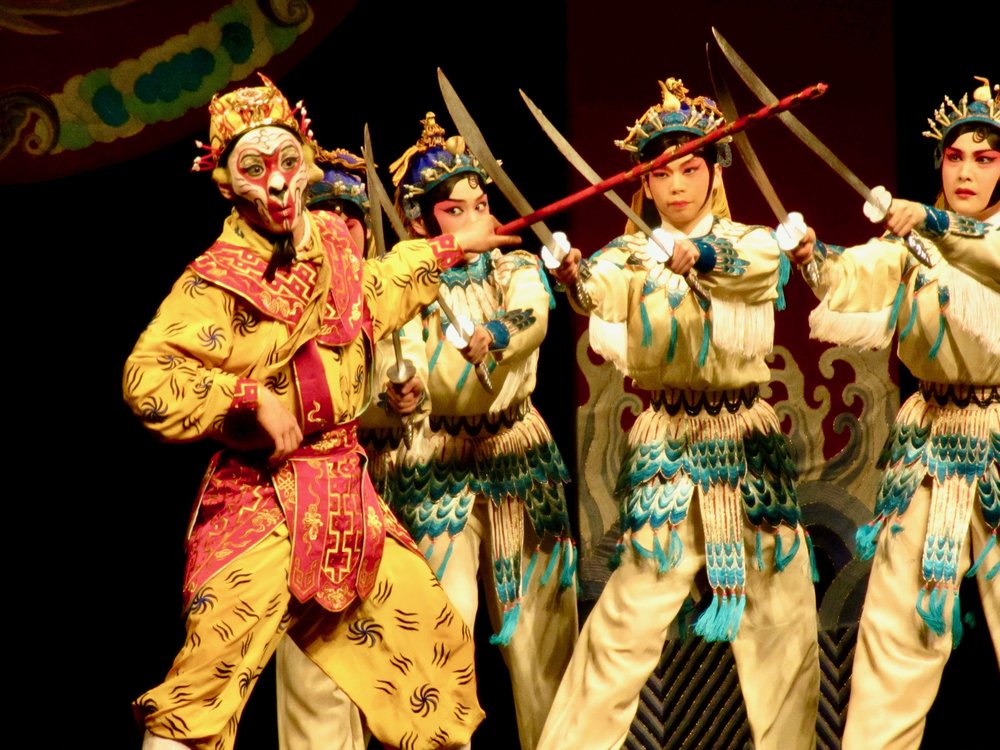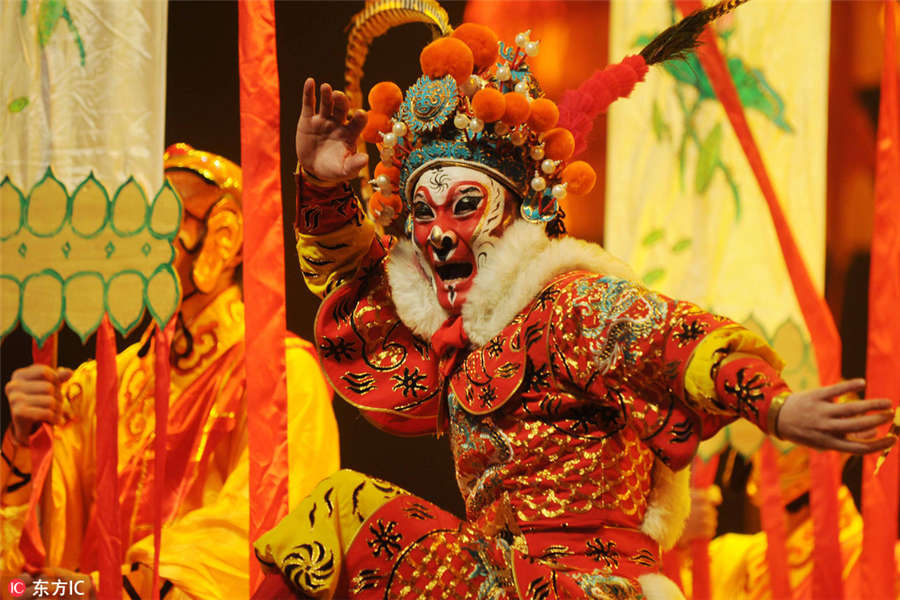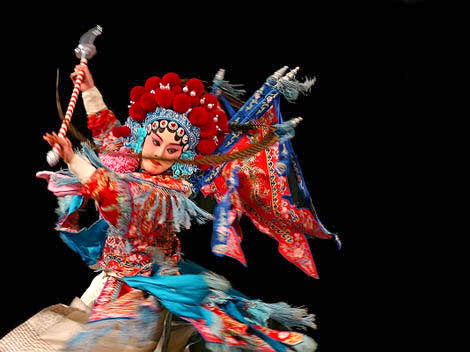A Brief Overview
The earliest known performances of Chinese song-drama date to 440 BCE, but the first modern golden age of drama in China dates to the early twelfth century where a style known as nanxi (southern drama) provided dramatic themes which lasted for centuries. The Ming and early Qing dynasties saw the expansion and growth of these ideas as regional theatrical styles developed, each with their own versions of folks-songs, music, and dialog, but with common story lines and subjects. It is hardly coincidental that this period coincides with rise of the vernacular novel and stories we learned about in class.
There was a more elegant and aristocratic style of opera-drama called Kunqu (tunes of Kun) that flourished near what is now Shanghai. Kunqu dramas featured elegant music and language and used the dizi (bamboo transverse flute) to accompany the songs and story. One of the leading dramatists of this style, was Xianzu (1550-1617) who is sometimes called China’s Shakespeare.

As you might expect, educated people admired Kunqu, but considered popular drama a lesser art form – one which they attended only to “keep an eye” on things and make sure the plays were not promoting subversive or improper ideas.
In 1790, the Qianlong emperor celebrated his eightieth birthday by inviting the Sanqing (Three Celebrations) opera troupe to Peking. The Sanqing troupe’s performances incorporated two kinds of melodies: Erhuang (named after a province in Jiangxi) and Xipi (“western skin” – or western singing). The fusion of these two styles was well known and very popular in the southern province ,but it was new to Beijing (Peking), and for this reason, 1790 is considered the birth year of the Peking Opera. All roles (male and female) were performed by men.
In 1860, the imperial court gave a formal stamp of approval to the vernacular operas. Until that time, only the Kunqu style had received formal recognition (although the court had been subsidizing and supporting training schools for many years). After Xianfeng’s death in 1861, the more populist and vernacular styles lost some of that support. But in 1884 the Empress Dowager, Cixi threw her enthusiastic support to the form. A theater district took root in Beijing near the south gate of the city, and opera thrived. Sadly, during the Boxer Rebellion, most of the theaters in the district were burned down.

During the republican era, there was a an attempt to “modernize” the opera forms. Dramatists developed long form operas, with multiple acts tied together by a central theme or conflict. They also tried to present a more realistic view of life, and incorporated more spoken dialog. They changed plot lines to feature rebellions against Imperial rule, and elevated heroes who arose from the working classes. By this time, women began to perform female roles (dan) themselves, and also took on some of the high-pitched male (xiaosheng) roles.
In 1958, Mao Zedong pushed for the development of “modern” opera, but also included traditional opera as an approved art form. The modern, revolutionary style did not catch on with the public, and in 1963 Jiang Qing (Mao Zedong’s wife) demanded the elimination of traditional opera. Most performers of the traditional operas were condemned and seen as feudal relics.
At the end of the Cultural Revolution in 1976, Deng Xiaoping welcomed the return of traditional opera, and threw the regime’s support behind it. He was, apparently, a big fan of the style.
But the future of this tradition is a bit uncertain. While there are still performances taking place in China, it no longer occupies a dominant role in cultural life, taking a back seat to cinema and popular culture. At the same time, audiences around the world have been exposed to these performances because of traveling troupes and televised performances, so it will be very interesting to see how and in what form the Chinese Opera will survive.
The Types of Roles Found in Chinese Opera
Actors in Chinese Opera train for specific types of roles. It takes years of training to master a “type,” and some family troupes were known for multiple generations of their female impersonation skills. There are multiple sub-types within these roles, and interestingly, the female roles have the largest variety. I think that these archetypes appear in the movies we watched and stories we studied- either by the specific character name, or by personality traits.
- DAN : These are females roles. Until the twentieth century, Dan roles were played by men who sometimes wore two-toed platform shoes so that they would move in the way Chinese aristocratic women (with bound feet) would move. The typical roles are: a young maiden(qingyi), a refined, private quarters woman (guimendan),a lively, flirtatious woman (huadan), an old woman (laodan), a warrior woman (wudan) and a weapon-and-horse woman (daomadan).
- SHENG: These are male roles. The young man(xiaosheng) sings in falsetto, and is often played by these days by a woman. The old man(laosheng) wears a beard and minimal makeup. The close combat warrior (duandawusheng) is an acrobatic warrior.
- PAINTED FACE (Jing or Dahualian): These are very striking characters, often generals or villains, with elaborate costumes. A white face characterizes treachery (like Cao Cao), a black face indicates impartiality and uprightness. Guan Yu is a painted face character in Chinese opera. These characters are larger than life!
- CLOWN: (Chou) This is the comic relief in an opera – Chou have a small, white patch of makeup around the nose, and speak in vernacular. Both men and women can act in chou roles.
The main theaters in Peking were also tea houses. Depending upon rank and economic status, theater goers could sit comfortably at a table and be served food and drink while the drama unfolded. This tradition flourished through the early 20th century. Plays themselves were episodic, drawing upon well-known historical events or popular novels. For many working class members of the audience, these operas were a significant education in history and tradition.
While struggle and conflict are part of the story line often revolving around themes that are known from our class (filial piety, moral reciprocity, wen and wu), the audiences expected a happy ending.
In the pure tradition, the opera stage is bare, and the curtain is behind the performers. There are no doors on the stage, and props are very simple – perhaps a table or some chairs, but not much else. Plays often began with a masked character (“sage”) who spoke about the philosophical and historical context of the of the story.
Battle scenes are wildly acrobatic – but explicit violence and death are never shown on the stage. When a character dies in traditional Chinese opera, he/she walks off the stage, and everyone understands what that means. Mime is an essential part of the story-telling, and there are some interesting conventions that are well understood by the audience. For example, walking in circles onstage tells the audience that the character is taking a long journey.
Here is a list of some of the best-known operas that will have connections to the stories we studied.
From Journey to the West
HAVOC IN HEAVEN
MONKEY STEALS THE MAGIC FAN
MONKEY AND THE WHITE BONE DEMON
MONKEY AND THE CAVE OF SPIDERS
From Romance of the Three Kingdoms
THE CHANGBAN SLOPES
THE HUARONG PASS
MEMORIAL TO A RIVAL
BURNING THE CAMPS
From Sima Qian
JING KE, THE LOYAL ASSASSIN

